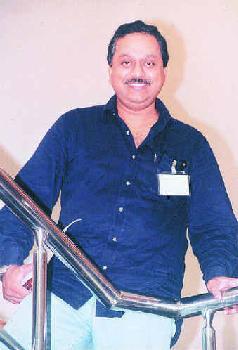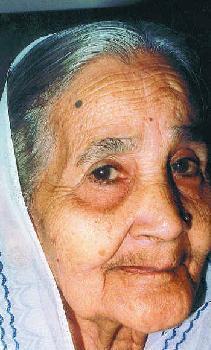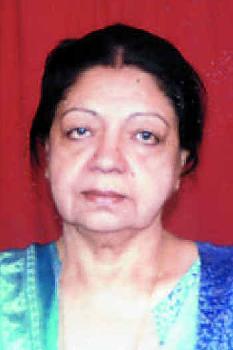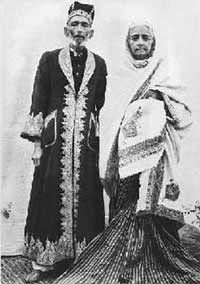Noida, UTTAR PRADESH / Hyderabad, TELANGANA :
Begum Laila Umahani, said to hail from the family of Bahadur Shah Zafar, is living a life of obscurity with her two sons. Film-maker Arijeet Gupta convinced her to talk of her pedigree for “The Living Moghuls”, a documentary on the descendants of the Moghuls. On the other hand, we have Pakeeza Sultan Begum asserting her case as the last known direct descendant. RANA A. SIDDIQUI reports… .

HE SCOOTS of to buy vegetables, leave his children at a local school and lives the life of a common man. He is Ziauddin Tucy. His mother tells fairy tales to her grandchildren. But those tales do not constitute fairies, who help people in their moments of distress. They talk of Moghuls, their grandeur, the last Moghul Emperor Bahadur Shah Zafar and his four wives till the period of what is called India’s First War of Independence – the Mutiny of 1857. All these not because the children have inclination for history of Moghuls but because their grandmother herself is said to be the last surviving member and direct descendant of Bahadur Shah Zafar and his first wife, Begum Ashraf Mahal.
Eighty-year-old Begum Laila Umahani, who lives in Asmangarh, a small city in Hyderabad, is this grandmother. She narrates the glorious family history to her grandchildren, knowing that it won’t have any takers if she goes to tell it to people beyond the periphery of her small house.
This is what Arijeet Gupta, the man behind the documentary “The Living Moghuls” screened at India Habitat Centre in New Delhi the other day, tries to prove. Said to be the first-ever archival documentary produced by Public Service Broadcasting Trust – PSBT and financed by Prasar Bharti, it traces the history of Moghuls from1857 to 2002 – a period of 145 years which saw the sudden disappearance of Moghuls from the historical centrestage. But Begum Laila Umahani helps tracing it when she reveals that after Bahadur Shah Zafar’s exile to Burma by the British in 1857, his son Mirza Quaish – the first generation — managed to save his life and fled to Kathmandu. After he secretly came back to India, he was given shelter by Maharana of Udaipur. His son Mirza Abdullah — the second generation — again a fugitive, went to Nagpur and then Aurangabad and finally Hyderabad. Here, Nizam of Hyderabad helped him. His son Mirza Pyre later married Habeeb Begum, hailing from the family of the sixth Nizam of Hyderabad. One “Habeeb Mahal” near Char Minar in Hyderabad, belongs to her which is occupied by one family and they have moved High Court for its possession. Begum Laila Umahani, daughter of Mirza is the fourth and only surviving Moghul from the family.

Begum Laila now lives in a rented house in Aamangarh with her two sons, Ziauddin Tucy and Masiduddin Tucy — the fifth generation. Her husband died earlier. While Ziauddin Tucy is retired marketing supervisor from Andhra Pradesh Government, Masiduddin Tucy is a food consultant in Welcome Group of Hotels in Hyderbad.
The family after several futile approaches made to Indira Gandhi and subsequent governments in Delhi, preferred to take a backseat “Who will listen to me now? Instead they will mock so it is better to remain silent to keep our dignity intact,” Begum Laila says in the documentary. She reportedly broke her silence before the camera after much coaxing from Arijeet Gupta.
There are historians who believe that it is difficult to trace that period after145 years. It simply because after Moghuls were deposed, many records also were destroyed. They were just fleeing for their lives and carried no identity cards.

The film-maker, Arijeet Gupta met the family in 1998 after he saw a letter from Ziauddin Tucy addressed to the powers that be requesting the family to grant benefits/ pensions to help them survive with dignity. Since Laila Begum was not ready to articulate her viewpoint, and there could not be many compromises on authenticity, this documentary took five years to complete, he says.
EVEN AS Begum Laila Umahani fights for recognition from the Government, she has to encounter another battle of words and letters – from Pakeeza Begum, claimed to be the only direct descendant of Bahadur Shah Zafar. A resident of Neeti Bagh in New Delhi — her ancestral house Chandni Mahal is in the Walled City — Begum Pakeeza denies that Begum Laila is a direct descendant of the last Moghul Emperor. “The entire Delhi knows that only I am only the direct descendant of the king and not she because only the heir apparent – Vali Ahad — was supposed to be one and Mirza Qwesh — whom she refers to as her forefather — was never a crown prince as reported in a Delhi daily earlier. He wanted to be one and to do that he also accepted the humiliating conditions of the British but never succeeded. While he was only attempting to become one, the 1857 Mutiny broke out. My great grandfather Mirza Fatehul Mulk was the heir apparent.”
She narrates the historical background that she says is found in record books too. It is reported that historians Maheshwar Dayal and Tara Chand also verified the same in their books. “Mirza Fatehul Mulk Bahadur alias Mirza Fakhruh was appointed the heir apparent in 1853. At the time of Mutiny, the son of Mirza Fakhruh, Mirza Farkhunda Jamal was only four or five year old. When Major Hudson killed the sons and grandsons of Bahadur Shah Zafar at Khooni Darwaza, Delhi on Bahadur Shah Zafar Marg, and soon after this news broke out, the nurse – Anna — of Mirza Farkhunda Jamal took the child secretly without even informing the family because those who were responsible for the Mutiny were among the family only. For years, she did not reveal his identity and nurtured him by doing different work at different places. That is how she managed to save the last successor.”

Some time after the Mutiny the British announced that there would be no killings and punishment, Anna brought the child back to the mother. The British Government released political pension in favour of Mirza Farkhunda Jamal as the heir apparent. After the death of Mirza Jamal, the pension was received by his sons and daughters — Qamar Sultan Begum — daughter of Mirza Jamal who kept receiving this share even after Independence. She refused to take it sometime after the Independence saying now we are free citizens and everyone is equal in this democratic country. Sultan Begum died in June 1993. She had two daughters, Begum Tahira Sultan and Pakeeza Sultan Begum. The former is settled in London while the latter lives in Delhi and is also an ex-director ICCR and an expert on Africa.
She questions the authenticity of Begum Laila’s statements: “Why was Mirza Qwesh running away even after the Mutiny? Despite the fact British announced that there would be no killings? Who was he afraid of? The British? Who, as her statements go that he was helped by the Indian soldiers of British Army to flee to Kathmandu? There were no Indian soldiers in British Army and even if there had been any, they were British soldiers and not from the King’s Army.”
She contends: “He was running away from his own people who got to know of his schemes and policies that he accepted the Britishers’ humiliating condition to become the successor of the Moghuls.”
The lady argues: “I don’t have any problem if she gets any help from the Government but she should not disturb the lineage by giving wrong statements.” She also expresses regret that without going to history books and records with the Government Arijeet Gupta went ahead to make his documentary film.
source: http://www.thehindu.com / The Hindu / Home> MetroPlus – Delhi / September 12th, 2002









